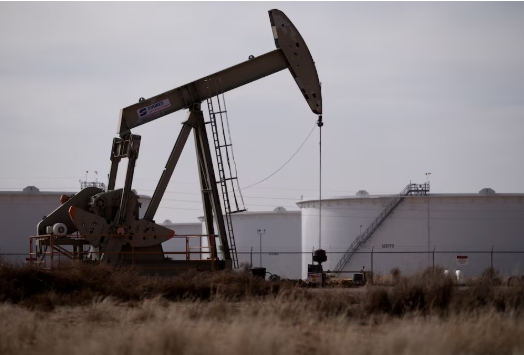
A pump jack operates near a crude oil reserve in the Permian Basin oil field near Midland, Texas, U.S. February 18, 2025.
The downward trend began after U.S. President Donald Trump introduced broad tariffs on most imports last week, raising fears that an escalating trade conflict could slow global economic growth and reduce fuel demand. The Brent futures premium over a six-month contract dropped to 98 cents per barrel, the lowest since mid-November, down from $3.53 on April 2 when the tariffs were first announced. This shift in market structure signals increasing investor unease about weakening crude demand and a potential oversupply.
The tariff measures intensified on Wednesday, with Trump’s 104% tariffs on Chinese goods taking effect at 12:01 a.m. EDT (0401 GMT). This followed Beijing’s refusal to remove its 34% retaliatory tariffs on U.S. products by a Tuesday noon deadline set by Trump, prompting an additional 50% tariff increase. Beijing stated it would not yield to what it described as U.S. pressure. Ye Lin, vice president of oil commodity markets at Rystad Energy, commented: "China’s aggressive retaliation diminishes the chances of a quick deal between the world’s two biggest economies, triggering mounting fears of economic recession across the globe." She noted that China’s oil demand growth, estimated at 50,000 to 100,000 barrels per day (bpd), could be jeopardized if the trade dispute persists, though increased domestic consumption support might offset some losses.
Adding pressure to prices, OPEC+—comprising the Organization of the Petroleum Exporting Countries and allies like Russia—decided last week to raise output by 411,000 bpd in May. Analysts suggest this could lead to a market surplus. Goldman Sachs predicts Brent and WTI prices may fall to $62 and $58 per barrel by December 2025, and further to $55 and $51 by December 2026. Meanwhile, Russia’s ESPO Blend oil price dipped below the $60 per barrel Western cap on Monday, a historic low.
Despite the gloom, U.S. crude inventories dropped by 1.1 million barrels for the week ending April 4, according to the American Petroleum Institute, against expectations of a 1.4 million-barrel increase. This offers a slight positive note amid widespread demand concerns.







